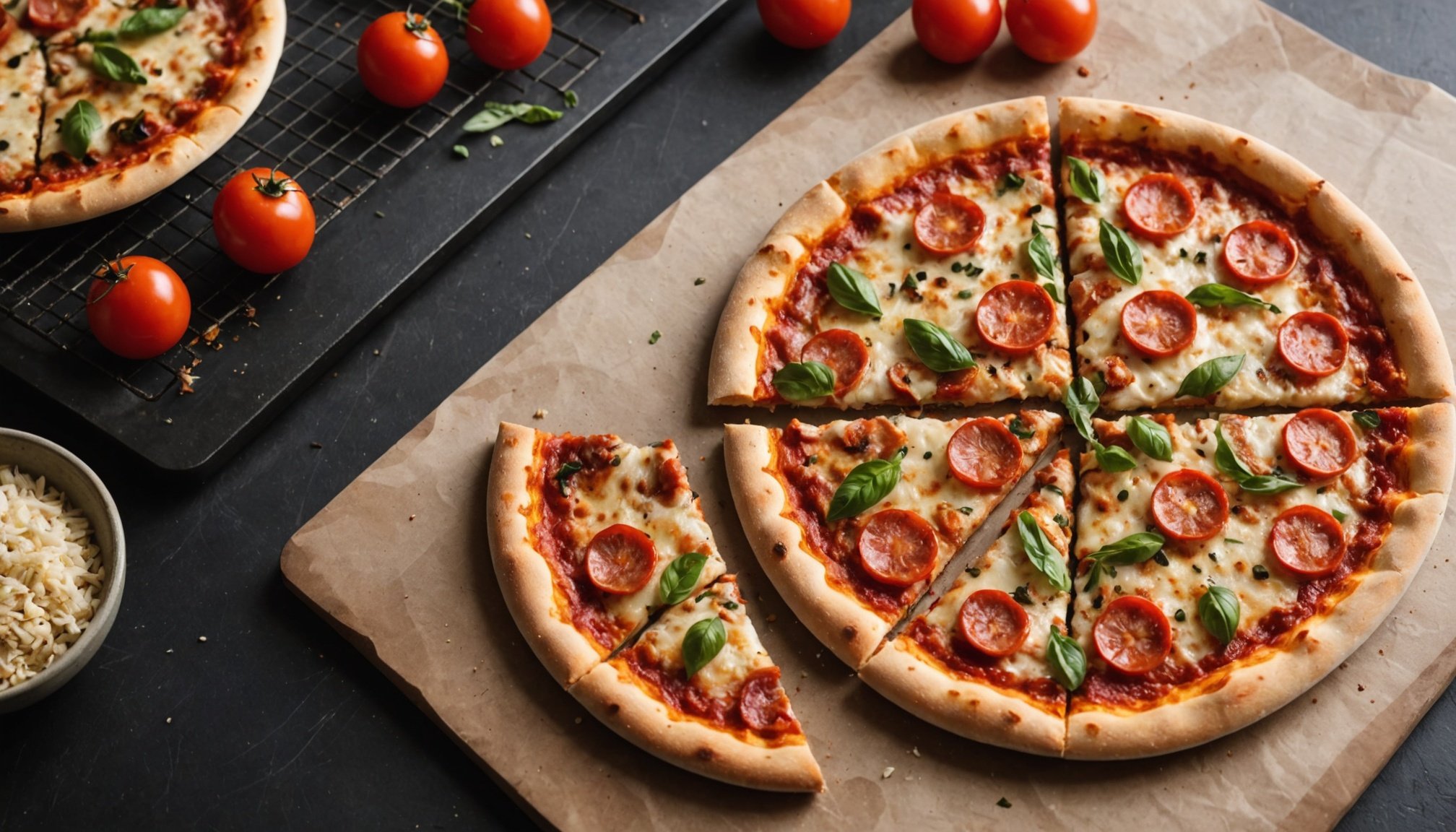Essential Attributes of a Quality Pizza Stone
Understanding what makes an ideal pizza stone is crucial for achieving that perfect crispy crust. One of the primary considerations is the type of material used. Cordierite, ceramic, and steel each offer distinct advantages. Cordierite is known for its excellent heat retention and durability, making it a top choice for many home cooks. Ceramic is prized for even cooking, although it might not be as robust as cordierite. Steel excels in heat conductivity, ensuring pizzas are cooked evenly but typically comes with a higher price tag.
Another significant factor is the thickness of a pizza stone, which influences its heat retention abilities. Thicker stones maintain heat longer, resulting in a satisfactory crispy crust. However, they may require longer preheat times. Optimal thickness usually ranges between 0.5 to 1 inch, allowing for a balance between heat retention and preheat efficiency.
Also read : Revamp Your Kitchen: The Ultimate Drawer Organizer for Effortless Bulky Utensil Storage!
Lastly, consider the size of your pizza stone relative to your home oven dimensions. It’s crucial for the stone to fit comfortably, allowing for even heating without restricting airflow. Choosing the right size ensures you get the best results from your home-baked pizzas.
Best Practices for Using Pizza Stones
A crucial step in achieving a crispy crust is preheating your pizza stone. For best results, place the stone in a cold oven and then heat the oven to the desired temperature. This ensures even heat distribution, essential for cooking evenly. Aim to preheat for at least 30 minutes before placing your pizza on it.
Additional reading : The Definitive Resource for Selecting a Heat-Resistant, Warp-Proof, and Non-Melting Soup Ladle
When it comes time to transfer the pizza onto the stone, the technique is key. Using a pizza peel dusted with cornmeal or flour can aid in smoothly sliding the pizza onto the heated surface without sticking. Alternatively, parchment paper can be a more straightforward solution for beginners, reducing the chance of mishaps during transfer.
Another aspect of using a pizza stone effectively involves managing the balance between thickness and heat retention. Thicker stones hold heat better, contributing to an evenly cooked and crispy crust; however, they might increase the preheating duration. Make sure to select the ideal pizza stone thickness that meets your baking preferences and oven capacity. Whether using cornmeal or parchment, developing a reliable transfer method ensures your baking endeavors are successful and enjoyable.
Maintenance and Care for Pizza Stones
A pizza stone is an investment, and proper maintenance ensures its longevity and performance, leading to many delicious, crispy pizzas. For effective cleaning, avoid soap or detergent, as these can seep into the porous surface. Instead, use a dry brush or scrape off any residue with a spatula after the stone has cooled. A damp cloth can be used if necessary, but the stone should be thoroughly dried afterward to prevent moisture absorption.
Preservation of your pizza stone also hinges on correct storage techniques. Ensure it’s stored in a dry place, away from any excessive moisture that could damage its structure. Placing it flat or in a vertical rack where it won’t easily tip or fall is ideal.
To preserve your pizza stone, avoid common errors, such as exposing it to thermal shock—this can occur if you place a cold stone into a hot oven or vice versa. Ensure that you heat the oven with the stone inside to mitigate this risk.
Sticking to these focused guidelines will promote your pizza stone’s durability, guaranteeing consistent, crispy crusts and a satisfying cooking experience.
Comparative Review of Popular Pizza Stone Brands
Exploring pizza stone reviews can significantly aid in selecting the ideal one for your needs. Recognizing how different brands compare is crucial. Let’s delve into the brand comparisons to understand the landscape.
Overview of Top Brands
Several brands stand out in the pizza stone market, each offering unique features and benefits. For example, Emile Henry is famous for its high-quality ceramic stones, noted for even heat distribution. Meanwhile, Pizzacraft offers innovative cordierite options, which satisfy those seeking excellent heat retention and durability.
Price vs. Performance Analysis
Not all pizza stones are priced equally, and sometimes the cost is not an indicator of performance. Emile Henry stones, although on the higher end, justify the price with impressive durability and performance. In contrast, Pizzacraft provides budget-friendly options without compromising significantly on effectiveness.
User Recommendations and Ratings
User experiences consistently highlight the quality and reliability of well-known brands. Emile Henry often receives praise for producing consistently crispy crusts, while Pizzacraft users appreciate its balance of affordability and functionality. Users recommend considering specific cooking needs and frequencies to determine the best value options, favouring brands that align with individual cooking styles.
The Role of Thickness in Pizza Stone Performance
The thickness of a pizza stone significantly influences its performance, particularly in terms of heat retention and achieving a perfectly crispy crust. A thicker stone retains heat more effectively, leading to consistent cooking and a delightful texture. However, it’s important to remember that with increased thickness comes a longer preheat time, demanding some patience before baking.
A recommended thickness range for homemade pizzas typically falls between 0.5 to 1 inch. This range provides an excellent balance between heat retention and preheating efficiency, making it suitable for various oven types and baking scenarios.
Understanding user experiences with different thicknesses can guide your choice. Many users report that thicker stones deliver superior results, producing pizzas with evenly cooked bases and attractive browning. However, some find that extremely thick stones can be cumbersome and more challenging to maneuver.
Considering your cooking preferences and oven capacity is essential when selecting the right thickness. Prioritise a stone that accommodates your baking routine, allowing for optimal results without unnecessary delays or difficulties in handling. Your choice will ultimately enhance your pizza-making experience, ensuring delicious, crispy creations every time.
Material Comparison of Pizza Stones
Selecting the right pizza stone material is essential for achieving that perfect crispy crust. Each material offers unique benefits and affects cooking performance differently.
Benefits of Cordierite
Cordierite pizza stones are particularly popular due to their remarkable heat retention capabilities. Known for their durability, these stones withstand high temperatures without cracking, making them ideal for frequent baking. Cordierite also evenly distributes heat across the pizza, resulting in consistently cooked bases.
Advantages of Ceramic
Ceramic stones are highly regarded for their ability to cook pizzas evenly. They are less durable than cordierite but excel in heat distribution, crucial for a balanced, crispy crust. Ceramic’s aesthetic appeal is another advantage, although care must be taken to avoid thermal shock.
Exploring Steel Pizza Stones
Steel pizza stones stand out because of their superior heat conductivity, providing even and fast cooking. Although steel carries a higher price, it quickly reaches baking temperature and delivers uniformly cooked pizzas. However, its heavyweight and maintenance requirements could be a drawback for some users.
Understanding these materials will guide you in choosing the most suitable option, enhancing your pizza baking experience significantly.






